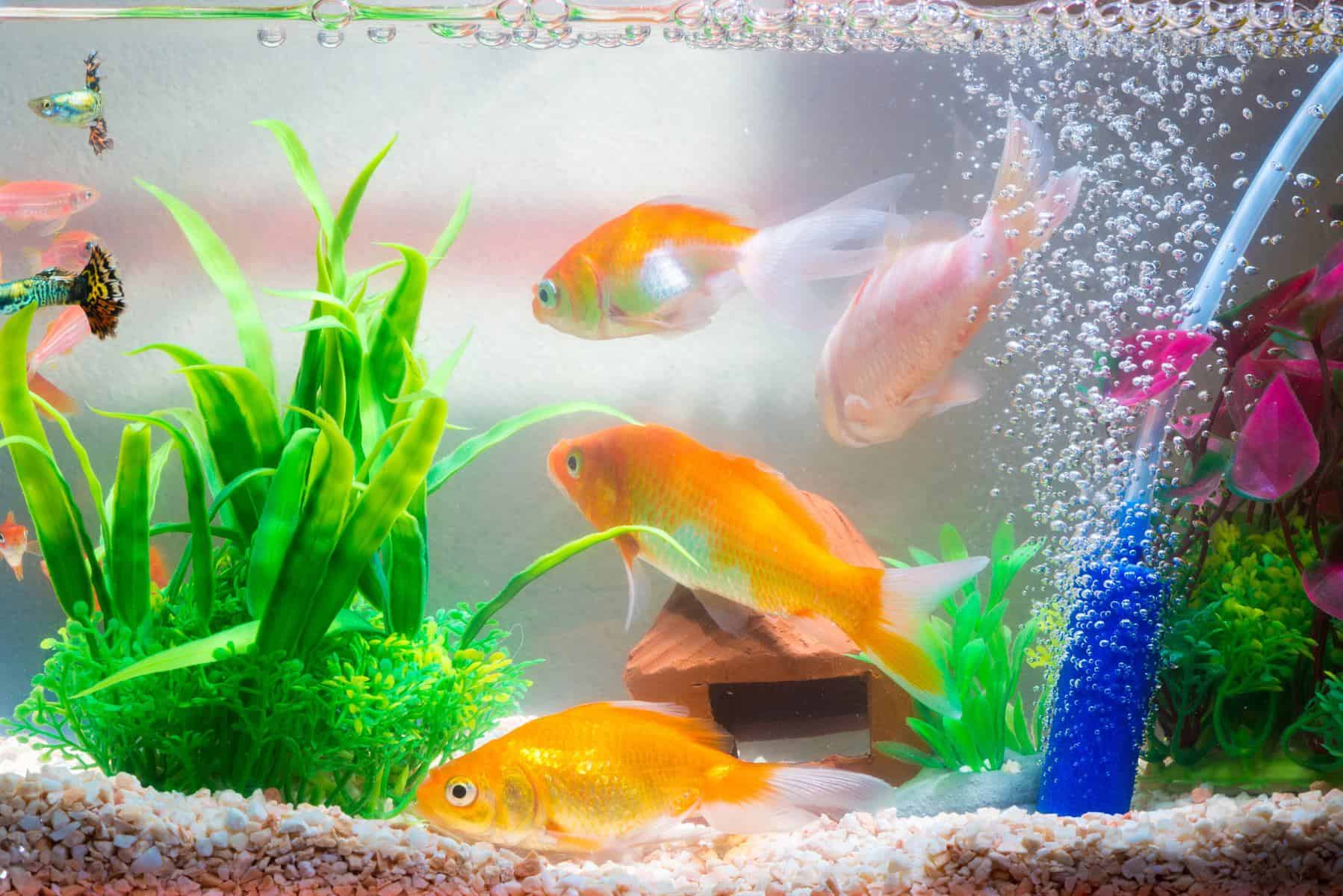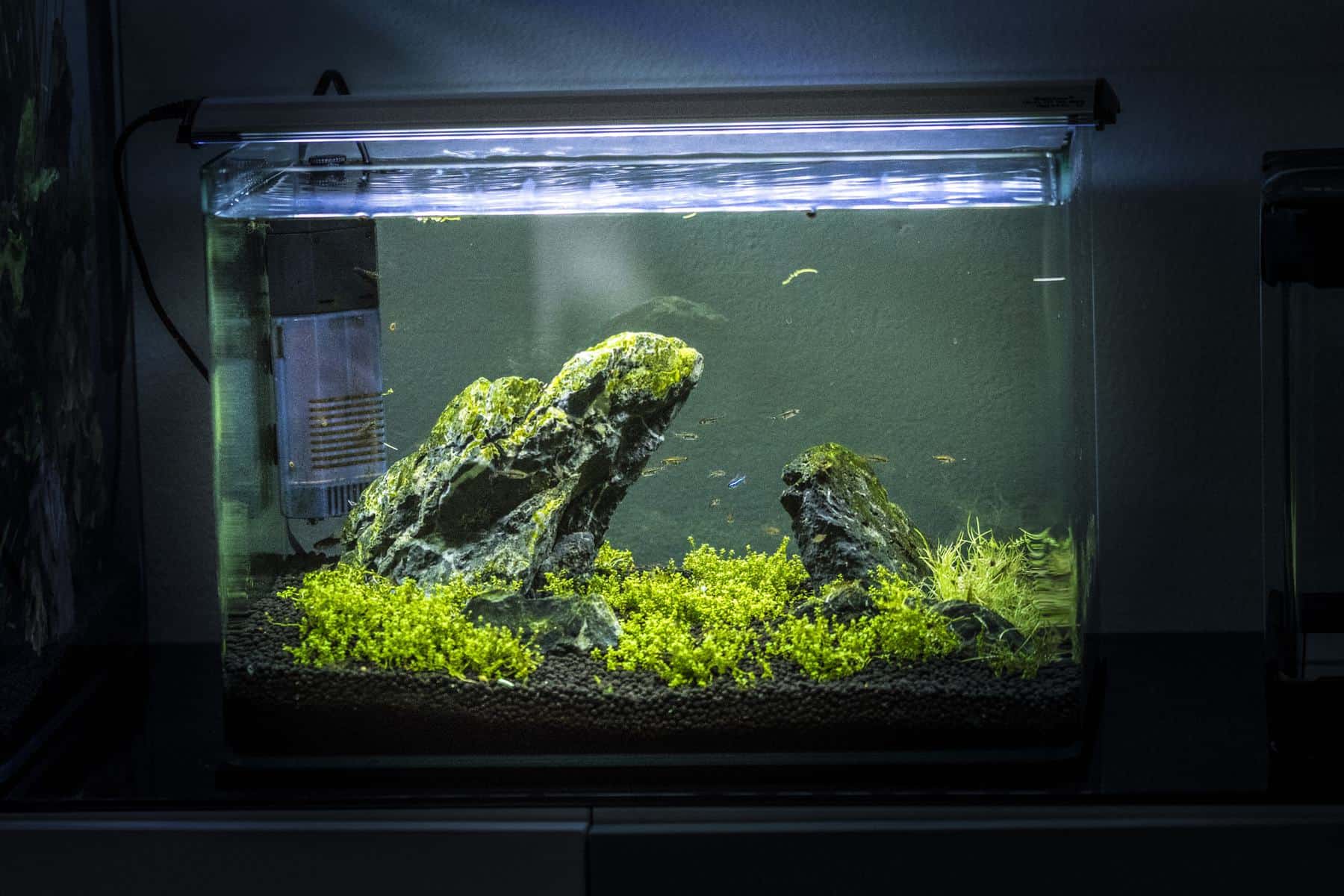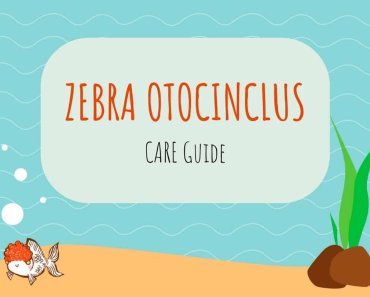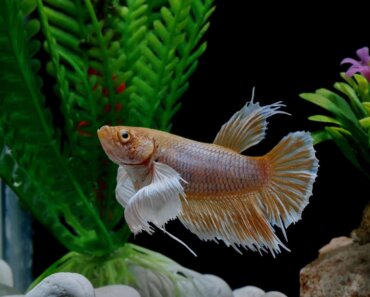If you’re just starting out with a new fish tank, you might have heard something about the aquarium cycle and allowing ammonia and nitrite to both hit 0 ppm before adding fish. It might seem a little confusing at first, but ammonia is an important biological aspect of aquatic systems that have to be dealt with in one way or another. Luckily, this is mostly done by microorganisms, but sometimes a little intervention is needed by way of a water change or chemical conditioners.
Keep reading to find out what ammonia is, how ammonia affects your tank, and what you need to do to keep your freshwater or saltwater fish tank from having an ammonia problem!
What is ammonia?
Ammonia (NH3) is a chemical compound that is often the result of decaying organic matter and general fish waste in the aquarium. At high levels, ammonia poisoning can quickly set in and affect all the organisms in your aquarium. Because of this, it is important to fully cycle a new fish tank and establish a biological filter.
Ammonia is the first step in facilitating the nitrogen cycle in an aquarium.
Aquarium nitrogen cycle
In short, ammonia is turned into nitrite that is then turned into nitrate by beneficial bacteria colonies populating the aquarium. First, a source of ammonia is needed to jumpstart the cycle as it is usually created through fish waste. Various aquarium-specific products may be used to dose ammonia, or pure ammonia may be added otherwise; another popular method is to ‘ghost feed’ which essentially allows uneaten food to decay and release ammonia.
Nitrifying bacteria will then perform nitrification which converts this ammonia to nitrites (NO2). These nitrites are then converted by another type of nitrifying bacteria into nitrates (NO3). At this point, the nitrates can be more easily taken up by plants and other organisms; once only nitrates are being detected with a test kit, the aquarium should then undergo a large water change. Fish may then finally be added.
All in all, the process of ammonia being converted into nitrates takes 3-6 weeks depending on certain circumstances.
What does ammonia do in the aquarium?
While ammonia might immediately seem like a bad thing to have in the aquarium, it is food for many microorganisms and plants.
Once the fish tank has been cycled, ammonia enters the system by way of fish waste. Due to certain metabolic functions, fish excrete waste as ammonia, which needs to be converted by the good bacteria in your fish tank. All of the uneaten fish food and other organic matter circulating throughout the tank also needs to be consumed by one organism or another and integrated back into both the food and nitrogen cycle.
In return, this bacteria feeds on this ammonia, reducing ammonia levels in your tank and keeping fish from getting ammonia poisoning. In addition, aquarium plants can readily take up ammonia, nitrite, and nitrate in order to grow, which helps lower and maintain those levels throughout the tank.
What causes ammonia in the fish tank?

Now that we know what ammonia is, how does it get into our fish tank systems? There’s usually a clear cause for ammonia levels being in our tanks, but sometimes the cause might be the source water, which we’ll discuss later.
However, the main causes of an ammonia problem stem from organic die off, overfeeding, overcrowding, or poor fish tank maintenance.
Die-off
Die-off is one of the biggest factors influencing the ammonia levels in your fish tank. Organic matter starts to decay and rot, which can lead to an overload of nutrients flooding the water column, including ammonia.
A dead fish will start to affect water quality after just a few hours. It is important to take count of all your tropical fish and invertebrates daily to make sure that a dead fish doesn’t start to decay in hard to reach spaces; all invertebrates should be accounted for as well. There is the chance that, given an efficient cleanup crew, you might not even have time to find the dead fish or invertebrate as the remains have already been consumed otherwise. However, it is still best to remove dead livestock when you see it.
Plants may start to decompose, which can also raise ammonia levels in the tank. While some members of the cleanup crew might be able to handle small plant die off, it is usually best to prune the plant before rot sets in and begins to produce ammonia.
If transferring live filter media or other decor from another fish tank, it is likely that you will experience some die-off; this is how some saltwater fish hobbyists begin their cycle with live rock. Due to changes in water quality and potential exposure to the air for too long, organic material starts to die off during the transfer. This usually leads to a traceable spike in ammonia in the fish tank over the next few days.
Overfeeding
Overfeeding can be just as dangerous as having a dead fish left in the tank. In a more direct way, uneaten food breaks down and releases nutrients into the water column; uneaten food can also start to rot if left in the fish tank for too long and produce ammonia.
Believe it or not, many fish actually don’t need to be fed that often; while most hobbyists likely to give their fish 2-3 feedings a day, it’s not entirely necessary, especially if the food is high in protein. More importantly, it is better to give a larger variety of high-quality foods in smaller portions rather than feeding more often with food that has little to no nutritional value.
As a general rule, only feed fish as much as they can eat in a couple of minutes and remove the excess; uneaten food is very likely to get stuck in filter pads, which can easily lead to ammonia leaking into the fish tank.
Overcrowding
Similar to overfeeding, overcrowding not only increases the amount of uneaten food entering the system but also the direct waste as a result of having that many more fish. Too many fish directly results in too much ammonia in the water, which can quickly lead to conditions that are toxic to fish and invertebrates; even worse, if these fish die, then they can create an ammonia spike due to decaying organic matter.
For freshwater fish, it is recommended to only have one inch (2.5 cm) of fish per gallon (3.8 L) of water. More than this can and will lead to too much waste as well as a depletion of dissolved oxygen as more fish means less oxygen and more carbon dioxide.
Poor fish tank maintenance
Lastly, a high ammonia level in the fish tank can be the result of poor maintenance. In general, it is recommended to perform partial water changes every week or every other week in a typical fish tank to keep nutrients down. Vacuuming the substrate also helps remove stuck organic matter and keeps anoxic areas from building up in the gravel or sand, which could potentially lead to nutrients leaking out later.
As we’ll discuss later, a simple water change is the best way of reducing ammonia levels in the aquarium; however, it’s best to keep on top of the problem by performing regular tank maintenance instead of waiting for the problem to present itself!
What are signs of ammonia in the fish tank?
The ammonia level can become high very quickly and start to affect aquarium livestock. It is important to regularly check all tank parameters and to immediately confirm they are where they’re supposed to be if you suspect there’s a problem. But what signs should you be looking out for and how do you know that the problem is the level of ammonia?
Odor
Fish tanks have a particular smell, but so does ammonia. One of the quickest ways to see if ammonia is in your tank is by taking a quick smell.
If you’re unfamiliar with what ammonia smells like, it is often likened to the odor of cat urine. The odor is crisp and foul-smelling, close to that of vinegar but still more fragrant. This smell will intensify with the level of ammonia present, but in general, ammonia is detectable by scent in relatively small amounts.
Of course, a test kit is a much more accurate way of determining if ammonia is present, but a little sniff can sometimes give an immediate yes/no answer.
Fish behavior
Besides the odor, fish behavior will be the telltale sign that ammonia is starting to have an effect on livestock. Ammonia poisoning can happen relatively quickly and can lead to a slow and painful death for fish, invertebrates, corals, and even plants. The main signs you will want to look out for are lethargy, gasping for air, and redness around the gills.
Lethargy
High levels of ammonia can directly burn the internal and external areas of your fish. The gills are usually affected the most and can start to overcompensate with mucus in order to try to relieve the burn. This ultimately leads to a lesser ability to absorb oxygen, in addition to the bloodstreams being compromised already from the burns. As a result, your fish will most likely lose its appetite. Swimming around can be painful and exhaustive, leaving your fish motionless on the bottom of your tank.
Gasping for air
Along with lethargy, you might find that your fish is struggling to breathe. This is due to the mucus that has been generated to help relieve the burns as well as damage to the gills and internal organs. For a tank with high ammonia levels, it is common to see fish breathing heavily and gasping for air. They will usually alternate between resting on the substrate and breathing heavy and gasping for air towards the top of the fish tank as that is where dissolved oxygen concentration is the highest.
Redness around gills
It is possible that your fish doesn’t display any of the aforementioned symptoms, but develops redness around its gills instead. This is due to the damage being done in and around the gills. These red spots can also appear across the body as the ammonia continues to burn. Along with being excruciatingly painful, these sores can become infected and lead to an even bigger problem.
What are the best ammonia removers for aquariums?
It should be noted that if you are starting a new tank, you do not want to lower ammonia unless levels get unmanageable. For the most part, hobbyists like to keep their ammonia between 1.0-2.0 ppm during the beginning stages of the cycle. At even higher ammonia levels than that, it is possible to stall the cycle; this means that your beneficial bacteria are not able to keep up with the amount of ammonia being produced in the tank. At that point, it may be necessary to reduce or get rid of the ammonia manually.
There are a few ways to lower ammonia levels in the fish tank, all of which can be pretty easily done.
Water changes
One of the easiest and most efficient ways of lowering ammonia levels is by performing one or more water changes. Water changes will immediately remove the ammonia from the fish tank and introduce safe water that will help dilute the remaining traces of ammonia left in the system. It is important to space water changes out over a couple of days to make sure that any fish or invertebrates aren’t being more stressed out than they already are.
Once you have tested your water quality and found that ammonia is the problem, it is best to perform a large water change of about 50%. Allow the system to realign and test the parameters the next day. If ammonia is still present, perform another partial water change of about 20-30%. Allow another day and test the water again. Perform partial water changes as needed under ammonia reads 0 ppm.
All the while, make sure to be looking for the cause of the high ammonia spike as ammonia will continue to be introduced into the water if something has died in the tank or if the aquarium is overcrowded.
Chemical supplement
Water changes are usually the easiest ways to solve a high ammonia level, but chemical supplements may sometimes be necessary and can be helpful to speed along a new tank.
Beneficial bacteria
There are many beneficial bacteria products that may be introduced into your aquarium to help keep nutrients at ideal ranges. However, these products will not immediately reduce ammonia levels. Instead, good bacteria is added into the aquarium to help the nitrogen cycle process faster.
Conditioners
One of the best products to have on hand at any given point is a water conditioner that removes chlorine as well as detoxifies ammonia, nitrite, and other heavy metals. While this won’t solve the direct ammonia problem, fish and other livestock should be affected less and more time will be given to figure out the origin of the problem.
Filter media
The last choice for reducing the level of ammonia in your aquarium should be filter media; in the case of an emergency, it is very unlikely that you will have ammonia-specific filter media laying around and ready to be used.
Filter pads and other media is often used as an extra preventative for fish with large bioloads, like goldfish. In general, they are best at creating additional space for beneficial bacteria to grow, which can help the nitrogen cycle be more efficient; however, once these filter pads and media have been expended, they can trap a lot of detritus and actually contribute to the ammonia level in the fish tank.
How long does it take to lower ammonia levels in the fish tank?
The problem with having ammonia in your tank is that you need to remove it as soon as possible all while not stressing out your fish even more. How fast ammonia leaves your tank depends on the cause of the problem in the first place, though lowering the ammonia levels to ‘safer’ levels can be done in a matter of days.
As mentioned before, if ammonia is present in a cycling fish tank, then this is normal. The ammonia will most likely show up on test kits for at least 1-3 weeks. After this, nitrites and nitrates should start appearing.
However, if this was a seemingly random spike of ammonia, then the amount of time will depend on how high the ammonia was allowed to go. Low levels can be solved with a simple water change, while higher levels might need several water changes and chemical supplements.
As always, the underlying issue needs to be discovered in order to fix the problem entirely.
How do you prevent ammonia in your aquarium?
It is well known that a fish tank doesn’t reach maturity until around 1-2 years. During the first year, the tank is most prone to algae and bacteria outbreaks as well as water parameter swings. Even then, sometimes the most mature tanks can experience high ammonia levels due to conditions changing in the tank.
If you’re one of those people with a young fish tank, how exactly can you prevent an ammonia spike from happening?
Test kits
If you don’t know what’s happening with the chemistry of your fish tank, then you don’t know what’s happening biologically. Regularly testing water parameters for at least the first year of a new tank is essential; beneficial bacteria is still populating, new livestock is being added, and you’re becoming familiar with how your mini-ecosystem operates! Some new fish tanks even go through mini-cycles because too much livestock was added before the beneficial bacteria could handle the increased bioload.
It is important to test your water in order to establish a base reading of water parameters to see where your tank operates at its best; remember, even though there is an ‘ideal’ set of water parameters for freshwater and saltwater tanks, some aquarium systems just do better outside that range; it might take some time to find where your fish tank does its best.
However, if water parameters start to deviate from this range, then it is time to take some precautions. In addition to having an up-to-date test kit, a plan for an emergency should always be laid out.
Test source water
Ammonia does not just show up in a fish tank on its own. It’s usually the result of some organic die off, overfeeding, overcrowding, or poor tank maintenance. However, there are times when it might seem like the ammonia is just appearing out of nowhere.
More likely than not, this is the result of ammonia being inputted into the system by way of an external source. One of these ways is by using source water with a traceable ammonia level. Many freshwater hobbyists like to use tap water so that they do not need to remineralize their water later, but public water has different regulations based on location; this means that it is possible that some traces of ammonia could be present in the water from your tap.
At the same time, ammonia could also possibly be found in any other source of water, like distilled or reverse osmosis (RO) water, just as easily. Whether this is due to dirty water filters or corroded pipes, unknown levels of ammonia could enter the fish tank without even being aware that you’re adding it.
While most of the time you can have confidence in your water supplier, it might be a good idea to test parameters every so often just to get a base reading. Tap water may also be sent out for ICP (inductively coupled plasma) analysis or a full analysis may be requested from the local water supplier.
Live plants
Live plants are not a good option to get rid of ammonia in a fish tank; rather, live plants are good to use in order to create a healthy, self-sustaining ecosystem that balances its own inputs and outputs.
Aquarium plants tend to favor nitrate (NO3) as their main essential nutrient, though they are also able to uptake ammonia (NH3), ammonium (NH4), and nitrite (NO2). This means that a relationship is established between the amount of waste being created in the tank and the health and growth of the plants in the system.
Live plants have many benefits, such as providing shading and shelter for an assortment of fish and invertebrates as well as making a natural backdrop. If you have a heavier bioload or just want to make sure that your fish are thriving as best they can, then live plants will help take up some of that extra ammonia.
Conclusion

Ammonia is an essential part of having a healthy and thriving fish tank, but if your system lacks the number of good bacteria needed to keep up with the input of ammonia, then the aquarium will run into problems. A high ammonia level could be the result of die-off, overfeeding, overcrowding, and poor fish tank maintenance.
Luckily, high ammonia levels are usually fixed by performing multiple water changes. However, chemical supplements may be needed in emergency situations. Otherwise, high ammonia levels can be prevented by regularly performing an ammonia test, checking parameters of the source water being used, and/or using live plants to naturally lower ammonia and ammonium.
If you have any questions about the nitrogen cycle, how to get rid of ammonia, or have had experience facing a serious ammonia problem in your fish tank, don’t hesitate to leave a comment below!


























